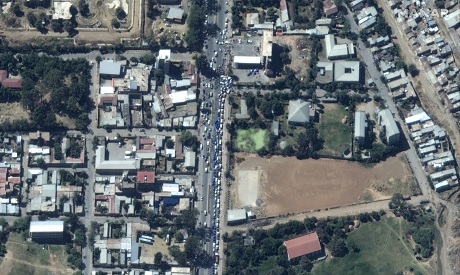
This satellite image taken Monday, Nov. 23, 2020 and released by Maxar Technologies, shows vehicles queuing for fuel in Mekele, the capital of the Tigray region of Ethiopia AP
Ethiopia's northern Tigray, where the federal army launched a military offensive against the regional leadership on November 4, has long had an outsized influence in the Horn of Africa nation.
- Rugged north -
Tigray is the northernmost of Ethiopia's ten regions, more than 600 kilometres (360 miles) from the capital Addis Ababa and administered under the system of "ethnic federalism" which divides the country according to language and ethnicity.
It is a landscape of rugged highlands and agricultural lowlands in which the majority is Tigrayan, a group that accounts for less than six percent of Ethiopia's population of 110 million.
Tigray borders Eritrea to the north with which Ethiopia has fought a frontier war in the past.
The regional capital, Mekele, lies in the east of Tigray with a population of around 500,000 inhabitants, roughly one-tenth of the region's mostly rural populace.
- Cultural and religious heritage -
Tigray has played a major role in Ethiopia's cultural and religious history, its heritage making it a major tourist draw for the country.
The ancient city of Axum is a UNESCO World Heritage Site and was the centre of a powerful kingdom from the 1st-9th century AD. It was Christianised by the Egyptian Church in the 4th century.
The city houses a famous obelisk, 24 metres high, that pre-dates the Christian era and is possibly as old as the 5th century BC.
Axum is also a sacred place for Ethiopian Orthodox Christians because Emperor Menelik I, considered to be the son of King Solomon and the Queen of Sheba, is believed to have brought the Ark of the Covenant there from Jerusalem, containing the Ten Commandments.
It is believed the Ark remains in Axum today, hidden from sight in the Church of St. Mary of Zion, the most sacred place in the Ethiopian Orthodox religion.
Mountainous Tigray is also home to dozens of other churches carved into the faces of rocky spires.
- Economic engine -
Tigray is an agricultural region producing several crops, including sesame for export, as well as being home to major national industries.
Ethiopia's biggest cement company, a major gold producer, and one of the country's largest textile factories are all located in Tigray, and have all had their bank accounts frozen since mid-November.
The federal government accuses the companies of providing financial support to the Tigray People's Liberation Front (TPLF), which it is battling.
- Political power, military might -
The TPLF dominated Ethiopia's political and security structures from 1991-2018, between the collapse of the brutal Marxist Derg regime, that it helped defeat, and the arrival in power of Prime Minister Abiy Ahmed.
For much of that period Ethiopia was run by the talismanic Tigrayan leader Meles Zenawi.
However, when Abiy -- who is from the Oromo ethnic group -- took over he began to strip power and influence from the TPLF. In response, its leaders withdrew to their northern stronghold and began to oppose his rule.
In September, the TPLF won all seats in an election held in defiance of Addis Ababa, which had ordered a postponement due to the coronavirus pandemic. The vote became one of the triggers of the current conflict.
Under Ethiopia's system of ethnic federalism, the TPLF's power is not restricted to politics. The party also commands regional armed forces of up to 200,000 troops (including regular, paramilitary and militia forces), according to William Davison of the International Crisis Group think tank.
The TPLF remains influential within the wider federal security and military apparatus, which it once dominated and where it still has allies, according to researcher Roland Marchal at Sciences Po.
Short link: